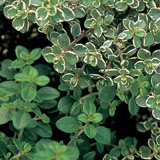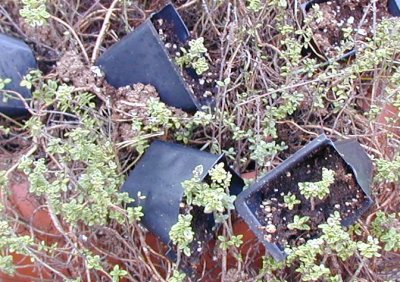Lemon thyme (Thymus x citriodorus) is a variegated light green herb. It has a woody stem and one small plant will grow to fill a large container in one season. This photo shows the lemon thyme in contrast to common thyme.

It smells like lemon and can be use for cooking just like any common thyme. The flavors and aromas are best represented when the plant is picked fresh. It will keep but the oils do not retain the citrus fragrance. The good news is it will grow on a window sill and with a little care the plant can be carried over for a few seasons.
We know of no source for lemon thyme seeds so that means the plant must be propagated by cuttings and by taking up trailing pieces which have rooted next to the mother plant. We have not had much luck with cuttings but we have developed a method that gives us good viable plants in a few weeks.
We start with a plant that is healthy and has new fresh growth. Then we take 6 pack plastic inserts and we cut them into individual sections.
Next we select a fresh looking sprig or two and thread them through the hole in the bottom of the plastic container. Rooting hormone can be used to help things along but it is not mandatory.
Then we fill the containers with soil and keep them damp for about 2 weeks. We check the containers for evidence of root growth.
Once the shoots are rooting nicely we clip them off from the mother plant and then cut the plastic container free, being careful not to break the roots. The plants are potted up into 3 inch pots and fertilized.
Here’s what it looks like. Some of the containers get flipped sideways but if the Pro-Mix is damp it usually does not fall out.

Lemon Thyme
We keep the starts a bit damp for about a week and then we allow them to go a bit dry between watering’s. They like full sun and will do well in very poor soil that is not too wet.
Another way to get plants is to grow it in a larger container and take the out-cropping that appear when a branch touches the ground and sends out roots.
We have taken small plants and potted them up in gallon containers with the tips of the branches sticking out. After a few weeks these branches will have put out roots and they can be separated into individual plants. Once they get going they branch out and fill a pot in no time.
We feed them with a low nitrogen fertilizer when rooting and a balanced fertilizer once they are potted up.
We have seen aphids on the lemon thyme but a few application of pyola oil takes care of them. Also they may be susceptible to scale and fungus so we treat them with serenade. Serenade is safe and can be applied to crops the same day they are picked.
We have plants that have be brought in for 3 or 4 years but they tend to get a bit straggly. It is a good idea to always keep a few good plants for future propagation.
Our original plant was a 3 dollar 3 in pot and that has served as the host for all the lemon thyme we have grown over the years. The original plant is over 2 feet in with and fills a very large terra cotta pot that we bring into the greenhouse for the winter.
In the summer the plant cascades down almost covering the pot. It is a nice plant to look at and make an interesting addition to herb gardens and baskets. The plant does flower but the variegated yellow and green leaves are so the main attraction.

Leave a Reply
You must be logged in to post a comment.